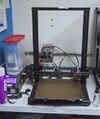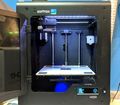Category:3D Printing
At MAG Laboratory, we maintain a collection of 3d printers assigned to different capabilities and materials. This page serves as an overview for our history, procedures, and equipment.
Equipment
Every printer other than the Zortrax M200 is capable of PLA. The Zortrax in particular is set aside as a "known good" printer, and it is placed at a high operating priority. With that said, some of its capabilities are considered "legacy," and large parts are not recommended since they have a high probability of failure. Many ad-hoc modifications have been implemented during prints on the Zortrax for warp-related failure prevention.
The Creality CR10S is placed at a lower priority. MAG Laboratory tries to keep either the Creality or the IIIP printing.
The IIIP is slated for trade once the Yangbot's proposed Prusa XL donation arrives. The Yangbot will receive the IIIP, and MAG Laboratory will receive a Prusa XL.
Members
The current lead of 3D printing activities defaults to the Chief Technical Officer since the suggested 3D printing position is not filled.
Procedures
The following are some of the recommended procedures that MAG Laboratory follows in order to ensure "good" 3d printing quality.
Filament Dehydration
MAG Laboratory has made it a priority to keep filament dry, so dry boxes are used for most printing operations. Symptoms of filament hydration include but are not limited to: filament running while the printer is idle, filament stringing, filament bubbling, print brittleness, print bubbling, and print failure. Filament that is not confirmed to be dry will often be placed on a 24hr+ filament dehydration cycle. PLA dehydration is often run longer since dehydration can not be performed at a higher temperature.
Printer Qualification
The usual low-reliability qualification print is low poly cat. Printers must complete the cat print at an acceptable quality to meet the minimum reliability level of testing.
As of 2022-09-03, a "bed adhesion testing" print of four solid-infill bicycle handlebar shims has been proposed.
When bed leveling fine-tuning is desired, a bed leveling print is performed.
Preventive Printer Maintenance
Ad-hoc preventive maintenance is performed on machines with sliding axes. Strategically placed globs of grease are dripped onto the linear axes while the printer is in operation. At times, a "grease on - grease off" approach is taken to remove contaminated grease.
Printer-out Maintenance
At times, printers will fail. MAG Laboratory takes a first-qualified-person approach to unscheduled 3d printer maintenance. When a printer-out event occurs, the stakeholders of the current 3d print queue are notified and printer repairs are undertaken. At times, printers will be placed on extended-offline for failure to meet qualification.
History
MAG Laboratory had a first-generation RepRap MendelMax 1.0 3d printer.
MAG Laboratory eventually received more 3d printer donations since members had printers that they did not use at home.
In November 2019, MAG Laboratory received a server rack that it converted into shelving for its 3d printers.
In June 2021, MAG Laboratory moved its printers to the table at the rear of the electronics room. Additionally, the mendelmax was returned to Trent.
Pages in category "3D Printing"
The following 5 pages are in this category, out of 5 total.






